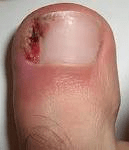
An ingrown toenail happens when one or both sides of the nail begin to grow into the soft skin of the toe. One of the first signs of an ingrown toenail is pain around the affected area.
In addition to pain, signs and symptoms of an infected ingrown toenail include:
- Liquid or pus discharge
- Warm to the touch
- Pink or red colour
- Swelling
- Foul odour
Causes
Many things can cause ingrown toenails. The most common cause of ingrown toenails is improper nail trimming. Cutting your toenails too short can result in the skin on the sides covering the corners of the nail. This causes the nail to grow into the skin.
Other common causes of ingrown toenails include:
- Poor-fitting shoes (shoes that are too tight or too narrow)
- Toe injuries
- Toe or foot deformities
- Cutting your nails in a rounded shape (they should be cut straight across)
- Regular physical activity or playing sports
- Toenails that are too large for your toes (genetic predisposition)
Risks
The biggest risk associated with an ingrown toenail is infection. Paronychia, which is commonly caused by ingrown nails, is an infection of the skin around a nail or toenail. The infection can cause the skin to become very swollen and painful. A pus-filled blister may also begin to form.
Paronychia often happens when the skin around a nail is injured or irritated. This can lead to bacteria entering the nail and causing bacterial paronychia.
If it is caught early, the condition can be treated at home. In rare cases, the infection may spread through the toe and into the bone. This is known as osteomyelitis.
A person with diabetes, nerve damage, or poor circulation may be more prone to infection because their wounds heal more slowly.
If you are concerned about your feet, call us today.
#stepandstridepodiatry #respod
(09) 212 9612
